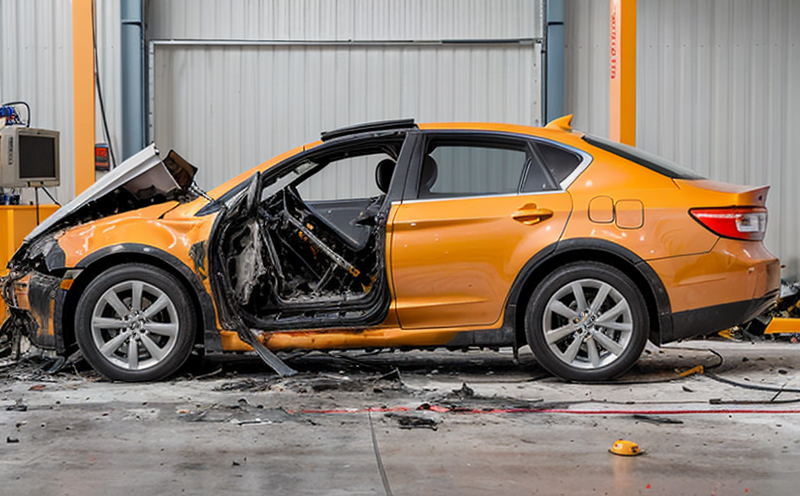UNE EN 50342 Crash Testing of Lead-Acid Automotive Batteries
The UNE EN 50342 standard is specifically designed to ensure that lead-acid automotive batteries meet stringent requirements for safety and performance under extreme conditions. This service focuses on the crash testing aspect, which simulates real-world scenarios where a vehicle might be involved in an accident or severe impact event.
Crash testing of lead-acid automotive batteries involves subjecting them to controlled impacts that mimic the forces experienced during vehicle crashes. The primary goal is to assess how well these batteries can withstand such stresses without compromising safety, performance, or integrity. This service ensures compliance with international standards and helps manufacturers meet regulatory requirements for product safety.
The testing process typically starts with careful preparation of the battery specimen. According to UNE EN 50342, the battery must be in a fully charged state before being subjected to the crash test. The specimen is then mounted on a fixture designed to simulate the orientation and position it would occupy within an automotive environment.
The actual impact occurs using specialized crash testing equipment capable of generating forces that replicate those found during real-world collisions. The force, velocity, angle, and other parameters are carefully controlled to ensure accurate representation of potential accident scenarios. Post-test inspection involves examining the battery for any signs of damage or failure, including structural integrity, electrical continuity, and leakage.
UNE EN 50342 specifies detailed acceptance criteria that must be met for a battery to pass this crash testing procedure successfully. These include visual inspection for visible damage, functional checks to verify operational capability post-impact, and sometimes even chemical analysis to check for internal integrity.
Crash testing of lead-acid automotive batteries is crucial because it helps identify potential weaknesses in design or manufacturing processes that could lead to hazardous situations during an accident. By adhering strictly to UNE EN 50342 guidelines, manufacturers can enhance the overall safety and reliability of their products, thereby protecting consumers from risks associated with defective batteries.
Understanding the importance of this service requires insight into its broader implications for automotive manufacturing and road safety initiatives globally. Ensuring compliance not only protects end-users but also contributes positively towards reducing accidents caused by faulty vehicle components like batteries.
Applied Standards
- UNE EN 50342: Crash testing of lead-acid automotive batteries
- ISO/IEC 17025 accreditation for the laboratory performing these tests
The UNE EN 50342 standard provides clear guidelines on how to conduct crash tests on lead-acid automotive batteries. It outlines specific conditions under which the test should be performed, including the type of impact forces applied and the angles at which they are delivered.
Accreditation from ISO/IEC 17025 ensures that our laboratory meets internationally recognized standards for technical competence in testing and calibration services. This accreditation guarantees the accuracy and reliability of all test results generated here, providing peace of mind to clients who rely on us for quality assurance purposes.
Benefits
- Compliance Assurance: Ensures adherence to international standards such as UNE EN 50342, helping manufacturers avoid costly penalties and recalls due to non-compliance.
- Enhanced Safety: Identifies potential hazards early in the development process, allowing for corrective actions that improve battery safety during accidents.
- Risk Mitigation: By identifying vulnerabilities through rigorous testing, companies can mitigate risks associated with defective batteries leading to accidents or fires.
The benefits extend beyond just meeting regulatory requirements; they also enhance brand reputation and customer trust. Consumers are increasingly aware of the importance of safety features in vehicles, especially when it comes to critical components like lead-acid automotive batteries.
Industry Applications
| Application Area | Description |
|---|---|
| Automotive Manufacturing | This service is essential for manufacturers who need to ensure their battery systems meet stringent safety standards before being incorporated into vehicles. |
| R&D & Development | Engineers can use this testing method during the research and development phase to refine designs and improve performance. |
| Quality Assurance & Compliance | This service helps quality assurance teams verify that their products comply with international standards, ensuring smooth passage through regulatory approvals. |
The application of UNE EN 50342 crash testing is not limited to automotive manufacturing alone but also finds relevance in various other sectors including R&D and quality assurance. For instance, researchers can leverage this service during the development stages to identify areas requiring improvement or innovation.





